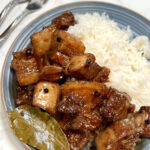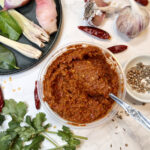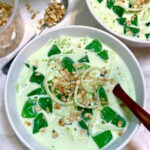Jajangmyeon consists of thick noodles coated in a savory black bean sauce, joined by chunks of pork, onions, cabbage, zucchini, and cucumbers. A beloved Korean-Chinese classic, it’s the ultimate comfort food, ready in just 30 minutes!
This dish is one of my go-to orders whenever I visit Korean restaurants in my city. My favorite location prides themselves in their signature seafood jajangmyeon, which I absolutely fell in love with right away.
Luckily, making this dish is fairly simple. Most, if not all, of the ingredients in this recipe can be purchase from your local Korean grocery store.

What is jajangmyeon?
Jajangmyeon emerged as a fusion of Chinese and Korean cuisine (aka. Junghwa Yori) as a result of early Chinese immigrants in Korea. Other Chinese-Korean dishes include tangsuyuk (sweet and sour pork, my personal favorite) and jjamppong (spicy seafood soup).
These noodles, in particular, originated from the dish Zha Jiang Mian, which you might be able to find in most Chinese restaurants. While similar in terms of their bean-based sauces, its Chinese counterpart tends to be slightly lighter and less sweet than jajangmyeon.

Black Bean Sauce
Korean-style black bean paste (chunjang) is primarily composed of fermented black soybeans, along with some salt, wheat, and flour. You can find chunjang in almost all Korean markets, but do know that different brands vary greatly in terms of their sweetness, saltiness, and sometimes savoriness.
The key step with jajangmyeon is to fry the black bean paste sufficiently enough to eliminate most of its bitterness. If your black bean sauce ends up tasting a little too bitter, it might be indicative of either an under stir-fried chunjang or you might have over-stir fried the paste to the point of being burnt! Balance is key.

In the end, you can always adjust the sauce according to your tastes. Sugar helps to balance out some of the bitter and savory notes of the chunjang. I also like to use chicken or beef stock , add in some MSG for extra umami, as well as a drizzle of sesame oil for some toastiness.
Instructions
Jajangmyeon Sauce:
Begin by heating 2 tbsp of oil over medium heat. Stir-fry the chunjang for 2-3 mins, stirring frequently to avoid burning and sticking. Set the stir-fried chunjang aside, leaving the frying oil in the pan.

In the remaining oil, fry the pork until cooked all the way through and its fats begin to render out. Season the pork with soy sauce, mirin, and ginger powder. Stir to combine.

Add in the onion and cook for 2-3 mins until just softened. Add in the cabbage, zucchini, and potatoes. Continue to cook for 7-10 minutes, or until the vegetables have slightly softened.

Add in the stir-fried chunjang, chicken stock, and sugar. Stir to combine until smooth. Place a lid, and let simmer for 5 minutes.

Drizzle in the cornstarch (dissolved in water) and sesame oil. Continue to simmer the sauce until thickened to your desired consistency, stirring occasionally.

Korean Noodles:
Boil the noodles until slightly al dente (the noodles should not be overcooked, they should still have a slight firmness when bitten).
Immediately drain the boiling liquid and run the noodles under cold water to keep them bouncy and chewy.
Serve the noodles with the jajangmyeon sauce. Top with slices of fresh cucumber, enjoy!

If you’re a huge fan of noodle dishes, give some of these recipes a try!:
- Creamy Sesame Noodles
- Pancit Bihon (Filipino Rice Noodles)
- Spicy Chili Oil Noodles
- Yaki Udon (Japanese Stir Fried Udon Noodles)
Disclosure: Some links on this page are affiliate links, meaning that at no additional cost to you, we may receive compensation from purchases made through these links. As an Amazon Associate, I can earn from qualifying purchases.







